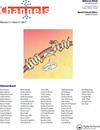Impaired cAMP-cGMP cross-talk during cardiac sympathetic dysautonomia
IF 3.2
3区 生物学
Q2 BIOCHEMISTRY & MOLECULAR BIOLOGY
引用次数: 5
Abstract
Dysautonomia is a well-established contributor to the development and progression of hypertension and many other cardiovascular diseases. Sympathetic hyperactivity and vagal impairment are features of human hypertension, as well as in subjects with a familial predisposition for hypertension. This neural phenotype is also observed in the spontaneously hypertensive rat (SHR). Moreover, it is widely accepted that autonomic imbalance contributes to the pathogenesis of hypertension itself, where emerging research is beginning to shed light on the key cellular and molecular changes that occur in diseased neurons. The postganglionic sympathetic stellate neurons (PGSNs) of the SHR that predominantly innervate the heart, display increased intracellular calcium [Ca2C]i transients linked to impaired neuronal nitric oxide synthase (nNOS) activity. Together, with downstream reductions in nitric oxide (NO)-cyclic guanosine monophosphate (cGMP), this results in enhanced end-organ neurotransmission. Pharmacological and genetic techniques aimed at enhancing NO-cGMPprotein kinase G (PKG) signaling have been successful in rectifying the Ca2C phenotype in SHR PGSNs and decreasing sympathetic hyperactivity. Interestingly, sympathetic impairment is present in young prohypertensive SHRs (pro-SHR), suggesting that these intracellular changes form early hallmarks of hypertension; however, the precise nature of events that trigger sympathetic dysfunction remain unclear. Recently, we published data suggesting that sympathetic hyperactivity in the stellate neurons from the pro-SHR may be triggered by dysregulated Ca2C channel activity, resulting in greater Ca2C influx. N-type Ca channels (Cav2.2) were identified as the major contributor to Ca2C entry in PGSNs, that in turn facilitate sympathetic neurotransmission. Inhibition of the N-type Ca2C channel also reduces the propensity for fatal ventricular arrhythmias and ameliorates autonomic dysfunction in a heart failure mouse model. When taken together these findings support a significant physiological role of the N-type Ca2C channel in neural modulation associated with cardiovascular disease. In our study we reported that PGSNwhole-cell Ca2C currents of the pro-SHR are greater when compared to normotensive rats. Moreover, we demonstrated a novel link between impaired cyclic nucleotide signaling and increased N-type Ca2C channel activity in prohypertension. cAMP and cGMP are ubiquitous second messenger cyclic nucleotide signaling molecules that regulate fundamental intracellular processes through direct activation of their respective kinases: protein kinase A (PKA) and PKG. Importantly, cyclic nucleotide regulation of neuronal [Ca2C]i is necessary for normal PGSN function. Indeed, site-specific phospho-regulation of several voltage-gated Ca2C channel subtypes has been well documented, where a fine balance between PKA and PKG activity is maintained in order to regulate Ca2C-dependent neurotransmission. Additional regulatory mechanisms are also maintained to ensure high signaling fidelity, whereby cAMP and cGMP are able to modulate alternative signaling心脏交感自主神经异常时cAMP-cGMP串扰受损
自主神经异常是高血压和许多其他心血管疾病发生和发展的重要因素。交感神经过度活跃和迷走神经损伤是人类高血压的特征,在高血压家族易感性的受试者中也是如此。这种神经表型也在自发性高血压大鼠(SHR)中观察到。此外,人们普遍认为自主神经失衡有助于高血压本身的发病机制,新兴研究开始揭示病变神经元中发生的关键细胞和分子变化。SHR的节后交感星状神经元(PGSNs)主要支配心脏,在与神经元一氧化氮合酶(nNOS)活性受损相关的瞬间,细胞内钙[Ca2C]增加。与下游一氧化氮(NO)-环鸟苷单磷酸(cGMP)的减少一起,这导致末梢器官神经传递增强。旨在增强no - cmpp蛋白激酶G (PKG)信号的药理学和遗传学技术已经成功地纠正了SHR PGSNs中的Ca2C表型并减少了交感神经亢进。有趣的是,交感神经损伤存在于年轻的高血压前期shr (pro-SHR)中,这表明这些细胞内变化形成了高血压的早期特征;然而,触发交感神经功能障碍的事件的确切性质尚不清楚。最近,我们发表的数据表明,来自前shr的星状神经元的交感神经过度活跃可能是由Ca2C通道活性失调引发的,导致Ca2C流入增加。n型Ca通道(Cav2.2)被认为是PGSNs中Ca2C进入的主要因素,进而促进交感神经传递。在心力衰竭小鼠模型中,抑制n型Ca2C通道也可降低致死性室性心律失常的倾向,并改善自主神经功能障碍。综上所述,这些发现支持了n型Ca2C通道在与心血管疾病相关的神经调节中的重要生理作用。在我们的研究中,我们报道了与正常大鼠相比,前shr的pgsn全细胞Ca2C电流更大。此外,我们证明了在高血压前期,环核苷酸信号受损和n型Ca2C通道活性增加之间存在新的联系。cAMP和cGMP是普遍存在的第二信使环核苷酸信号分子,它们通过直接激活各自的激酶:蛋白激酶A (PKA)和PKG来调节细胞内的基本过程。重要的是,环核苷酸对神经元[Ca2C]i的调节是正常PGSN功能所必需的。事实上,一些电压门控Ca2C通道亚型的位点特异性磷酸化调节已经得到了很好的记录,其中PKA和PKG活性之间保持了良好的平衡,以调节Ca2C依赖性神经传递。额外的调节机制也被维持以确保高信号保真度,因此cAMP和cGMP能够调节替代信号
本文章由计算机程序翻译,如有差异,请以英文原文为准。
求助全文
约1分钟内获得全文
求助全文
来源期刊

Channels
生物-生化与分子生物学
CiteScore
5.90
自引率
0.00%
发文量
21
审稿时长
6-12 weeks
期刊介绍:
Channels is an open access journal for all aspects of ion channel research. The journal publishes high quality papers that shed new light on ion channel and ion transporter/exchanger function, structure, biophysics, pharmacology, and regulation in health and disease.
Channels welcomes interdisciplinary approaches that address ion channel physiology in areas such as neuroscience, cardiovascular sciences, cancer research, endocrinology, and gastroenterology. Our aim is to foster communication among the ion channel and transporter communities and facilitate the advancement of the field.
 求助内容:
求助内容: 应助结果提醒方式:
应助结果提醒方式:


